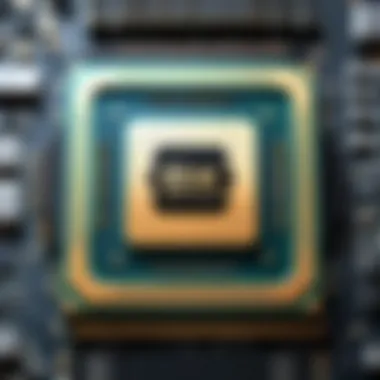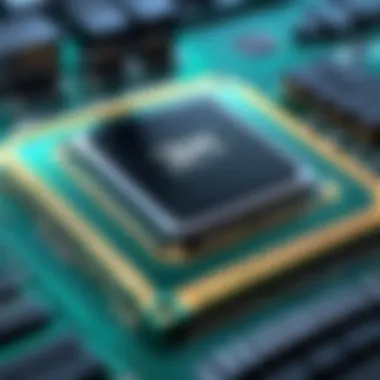Selecting the Best CPU for Video Editing Tasks


Intro
Choosing the right CPU for video editing can significantly impact your work efficiency and the quality of your projects. In today’s fast-paced digital landscape, video content creation has surged in popularity. As a result, selecting an optimal CPU tailored for this specific task becomes crucial. The CPU is not merely the brain of your computer; it acts as the primary factor in determining the speed and responsiveness of your editing software, impacting everything from rendering times to overall system stability.
In this guide, we will delve into the essential factors that inform your CPU selection process. We evaluate core counts, clock speeds, and architectural designs and how each of these specifications aligns with the unique requirements of video editing tasks. By providing a meticulous analysis of popular CPU models, we aim to equip IT professionals and tech enthusiasts with the knowledge necessary to make informed hardware choices, thereby enhancing their video editing capabilities.
Prelude to Video Editing Hardware
Video editing has become an essential part of many creative ventures, from professional filmmakers to casual content creators. Selecting the right hardware for video editing is crucial to ensure smooth workflows and quality output. Among various hardware components, the CPU plays a pivotal role. This section will shed light on the importance of understanding video editing hardware and specifically focus on how the CPU influences the editing process.
Understanding Video Editing Fundamentals
Video editing involves manipulating and rearranging video footage to create a polished final product. This process requires complex calculations and substantial computing power. Essentially, video editing software takes multiple video clips, graphic overlays, audio tracks, and effects, then assembles them into a cohesive piece. The more complex the edit, the greater the demands on the hardware.
Basic understanding of video resolutions, frame rates, and file formats is essential. Different resolutions, like 1080p or 4K, will impact how much data the CPU must process. Furthermore, higher frame rates lead to an increased demand for processing power.
The types of files you work with also determine hardware requirements. Compressed formats, while convenient, may still require substantial rendering capability to ensure high-quality playback and editing. This fundamental knowledge lays a foundation for selecting the ideal CPU for your needs.
The Role of the CPU in Video Editing
The CPU, or Central Processing Unit, is often referred to as the brain of the computer. In video editing, it handles various tasks, including rendering effects, encoding footage, and processing real-time playback. A powerful CPU accelerates these tasks, leading to more efficient workflows.
When evaluating CPUs, it is essential to consider core count. CPUs with higher core counts can execute multiple processes simultaneously, which is crucial during rendering and exporting tasks. Clock speed is another vital factor. It determines how fast a CPU can process instructions. Turbo Boost technology also enables certain cores to run faster under specific conditions, enhancing performance in demanding tasks.
Thermal management is equally important. High-performance CPUs produce more heat, requiring adequate cooling solutions to maintain optimal performance. Poor heat management can lead to throttling, causing significant slowdowns during heavy tasks like video rendering.
"The right CPU is not just about performance; it's about how well it integrates with the entire editing setup and workflow."
In summary, understanding video editing fundamentals and the specific role of the CPU can help you select the right hardware for your creative endeavors. With advancements in software and technology, ensuring that your CPU aligns with your editing needs is more important than ever.
Key Specifications to Consider
When selecting a CPU for video editing, several key specifications play a critical role in determining overall performance. Understanding these specifications can help you make an informed decision that aligns with your editing needs and budget. Therefore, highlighting these elements is paramount for anyone looking to enhance their video editing capabilities through optimal hardware choices.
Core Count
The core count of a CPU refers to the number of individual processing units within the chip. More cores can handle more simultaneous tasks, which is critical for video editing where multiple processes run in parallel. Modern video editing software, like Adobe Premiere Pro and DaVinci Resolve, are designed to utilize multiple cores effectively. Generally, a higher core count leads to better multitasking ability and improved rendering times.


For instance, while a quad-core processor may suffice for basic editing tasks, an octa-core or even a hexa-core CPU can significantly decrease render times and improve playback performance during editing. When working with high-resolution footage or multiple video streams, choosing a CPU with a higher core count becomes essential.
Clock Speed and Turbo Boost
Clock speed, measured in gigahertz (GHz), indicates how fast a CPU can process instructions. A higher clock speed often means better performance, but it is not the only factor to consider. Turbo Boost technology allows the CPU to increase its clock speed for short periods, giving a performance boost when needed. This is particularly advantageous during demanding tasks like effects rendering or high-resolution video output.
However, it is vital to balance clock speed with core count. A CPU with fewer cores but a significantly higher clock speed may not perform as well as a CPU with more cores and slightly lower speeds in video editing scenarios. Therefore, evaluating clock speed alongside core functionality is necessary for optimal performance.
Thermal Design Power (TDP)
Thermal Design Power (TDP) measures how much heat a CPU generates under standard operating conditions. It is expressed in watts and is a crucial specification, especially for video editing tasks that involve prolonged high workloads. A CPU with a high TDP may require more robust cooling systems to prevent overheating.
This is particularly relevant for those working in tight spaces or compact setups. Understanding the TDP helps inform your choice of cooling solutions. Higher TDP values might necessitate advanced cooling solutions like liquid cooling systems, while lower values may allow for standard air coolers.
In summary, considering TDP is important to maintain system stability, performance, and longevity when engaging in resource-intensive editing tasks.
Top CPU Models for Video Editing
Selecting the right CPU model is crucial for achieving optimal performance in video editing. Each CPU has unique characteristics that can dramatically affect editing speed and rendering quality. When considering CPU models, factors such as core count, clock speed, and architecture play significant roles. High core counts and advanced architectures often lead to smoother multitasking while handling heavy video files. This section reviews standout CPUs in the market, looking closely at their performance and suitability for video editing tasks.
Intel Core i9 Series
The Intel Core i9 series stands as a powerhouse for professional video editors. These CPUs are designed for those who require maximum performance for demanding tasks, including 4K and 8K video processing. With core counts that can reach up to 18 cores in some models, the i9 is capable of executing numerous threads simultaneously. Additionally, the base clock speeds often start at a robust 3.5 GHz, with Turbo Boost technology pushing speeds even higher during intensive tasks. This capability is particularly beneficial when rendering complex videos or utilizing multiple editing software at once. Overall, the Intel Core i9 series offers exceptional performance but comes at a premium price, making it a worthy investment for serious video editing workflows.
AMD Ryzen Threadripper
The AMD Ryzen Threadripper represents a unique offering with its focus on high core counts and multitasking capabilities. With options boasting up to 64 cores, the Threadripper excels in parallel processing tasks, making it a favorite among professionals who work with heavy video files or complex effects. The architecture of Threadripper CPUs often results in good performance for multi-threaded applications. Moreover, with higher thermal design power ratings, additional cooling solutions may be necessary but can be easily accommodated. This CPU choice is ideal for those looking to future-proof their editing capabilities without compromising on speed.
AMD Ryzen Series
The AMD Ryzen 5000 Series has become popular for video editing due to its favorable price-to-performance ratio. With architecture improvements, these CPUs deliver strong single-threaded and multi-threaded performance. Models within this series commonly feature up to 16 cores, providing sufficient power for most editing tasks. The base clock speeds range around 3.6 GHz, with Turbo Boost allowing for increased performance when needed. The Ryzen 5000 series is particularly attractive for budget-conscious editors seeking capable processors that do not skimp on performance. This option balances capability with affordability, making it a strong contender for a variety of editing situations.
Intel Core i7 Series
The Intel Core i7 series also serves as a reliable choice for video editing tasks. Slightly less powerful than the i9, i7 CPUs still deliver significant capability with core counts ranging from 4 to 10, depending on the model. Generally, these CPUs operate with base clock speeds around 2.9 GHz to 4.7 GHz, providing versatility for different types of video editing tasks. For editors working on less complex projects or those not requiring excessive render times, the i7 offers a solid performance without the higher costs associated with the i9 series. Its balance of performance and price makes this an ideal option for freelancers or small studios.
"When selecting a CPU, consider both current needs and future demands to ensure longevity and productivity."
In summary, evaluating top CPU models for video editing requires a careful consideration of specific needs, budget, and intended use. Each model has its advantages, but making an informed choice can significantly enhance the editing experience.


Comparative Analysis of Leading CPUs
A comprehensive analysis of leading CPUs is paramount when selecting the right processor for video editing. This examination allows users to make decisions based on empirical data rather than speculation. Performance benchmarks and the price-to-performance ratio emerge as critical elements in this analysis, as they reflect how well a CPU can handle intensive video tasks relative to its cost.
By understanding how different CPUs stack up against each other, whether it be in rendering speed or multitasking capabilities, users can make informed choices that align with their specific editing needs. Moreover, choosing a CPU is not just about current requirements; it's about anticipating future needs as video editing software evolves, further underscoring the importance of thorough analysis.
Performance Benchmarks
Performance benchmarks serve as quantitative indicators of a CPU's capability in handling video editing tasks. These benchmarks typically involve standardized tests that measure processing speed, multitasking performance, rendering efficiency, and overall responsiveness.
In the context of video editing, a few notable benchmarks include:
- Cinebench R20: Focuses on CPU rendering performance, simulating real-world scenarios.
- Handbrake: Tests CPU's encoding capabilities, crucial for rendering videos quickly.
- Adobe Premiere Pro Benchmarks: Evaluate Adobe's popular editing software’s performance on different processors, a critical factor for editors using this software.
Engaging in this benchmarking analysis gives a fuller picture of how a CPU can perform during actual video editing sessions. Consider reviews and reports from seasoned professionals in the field, as they often provide insights on performance in practical scenarios, potentially revealing strengths that numbers alone cannot convey.
Price-to-Performance Ratio
The price-to-performance ratio is essential when investing in a CPU for video editing. It reflects how much performance a user can expect for the price paid. A high price does not always guarantee high performance, making it crucial to analyze this ratio carefully.
When evaluating this ratio, consider the following:
- Comparative Performance: Set benchmarks against the cost of CPUs. For instance, if an Intel Core i9 processor offers significant boosts in rendering speed compared to a Ryzen 7 but costs substantially more, one must weigh whether the difference in performance justifies the price difference for their specific needs.
- Long-term Value: Sometimes, a slightly more expensive CPU may save costs over time due to prolonged usability in future software updates and more demanding tasks.
"Investing in a CPU that balances both performance and cost is key to ensuring your video editing setup remains relevant and efficient as software requirements grow."
- Usage Patterns: The best choice varies greatly depending on whether the individual is a professional editor needing top-tier performance or an occasional user.
Understanding the price-to-performance ratio equips users with knowledge to avoid overspending while ensuring the CPU selected meets their editing needs efficiently. Analyzing the comparative performance alongside costs allows for a more informed decision that aligns with both immediate and future requirements.
Future-Proofing Your CPU Choice
When selecting a CPU for video editing, future-proofing is key in ensuring your hardware remains relevant as software and user demands evolve. Given the rapid advancement in video editing technologies, investing in a CPU that can adapt to emerging trends is crucial. It can save time and money in the long run while maximizing productivity. A well-chosen CPU will not only handle current software requirements but also be capable of managing future developments in video editing and production, which often involve higher resolutions and more complex effects.
Trends in Video Editing Software
Several trends are emerging in video editing software that impact CPU selection.
- Increased Use of 4K and 8K Video: As cameras become more capable of shooting in ultra-high-definition, software needs processing capacity to handle larger data streams.
- AI Integration: More software now leverages artificial intelligence for tasks such as color correction and video enhancement. This demands more powerful CPUs able to support optimized algorithms.
- Collaboration Features: Online collaboration is increasingly essential. This often requires real-time rendering and processing of projects, which can strain less capable CPUs.


Investing in a CPU that can handle these trends is essential for long-term viability.
Emerging Technologies Impacting Video Editing
Numerous emerging technologies are shaping the landscape of video editing.
- Hardware Acceleration: Graphics processing units (GPUs) are now often utilized in tandem with CPUs to speed up rendering and effects processing. A CPU that pairs well with high-performance GPUs can enhance overall system efficiency.
- Cloud Editing Solutions: The rise of cloud computing affects how CPUs are leveraged. This shift often necessitates CPUs capable of efficient data handling and network communication.
- Real-time Editing: Tools that offer real-time editing require strong processing power. This often translates to the need for CPUs with higher core counts and better multi-threading capabilities.
Compatibility Considerations
When selecting a CPU for video editing, compatibility is a crucial factor that can determine the overall performance and stability of the system. In this section, we will discuss two major aspects: motherboard compatibility and cooling solutions. Understanding these elements helps to ensure that the components work well together, maximizing the efficiency of video editing tasks.
Motherboard Compatibility
The motherboard is the backbone of a computer system. It connects the CPU, RAM, storage, and other peripherals. When choosing a CPU, you must consider whether your motherboard supports its architecture and specifications. Each CPU family, whether from Intel or AMD, has particular socket types, which determine compatibility.
For example, Intel’s Core i9 series utilizes the LGA 2066 or LGA 1200 socket, depending on the generation. In contrast, AMD’s Ryzen Threadripper requires an sTR4 socket. Before purchasing a CPU, verify the socket type and ensure your motherboard supports it. Furthermore, ensure that the motherboard's power delivery is capable of handling the CPU's Thermal Design Power (TDP). This is pivotal as CPUs with higher TDPs demand more robust power solutions for stability during intensive tasks, such as video rendering.
In addition to socket compatibility, you should also consider the chipset on the motherboard. Chipsets dictate features like overclocking capabilities, supported technologies like PCIe lanes for GPUs, RAM speed compatibility, and more. If you want to maximize performance, choose a motherboard with a higher-end chipset that matches your CPU choice.
Cooling Solutions
Effective cooling is essential for maintaining the performance of a CPU, particularly during the high load of video editing tasks. Higher-end CPUs often generate significant heat, which can lead to thermal throttling if not properly managed. Choosing the right cooling solution, whether air or liquid cooling, can directly affect the system's stability and performance.
When considering cooling solutions, check the thermal resistance rating of your CPU. Higher performance CPUs tend to generate more heat, thus requiring more robust cooling systems. Air coolers, like those from Noctua or Cooler Master, can suffice for many users, but for high-end setups, liquid cooling from manufacturers like Corsair or NZXT may offer superior heat dissipation.
Finale
In summary, ensuring compatibility between your CPU and the motherboard, along with adequate cooling solutions, is essential for optimal video editing performance. These considerations directly influence the stability and efficiency of your setup, enabling smoother video editing experiences. This attention to detail not only extends the lifespan of your hardware but can also dramatically enhance your productivity.
Epilogue
Selecting the optimal CPU for video editing is a critical decision that can significantly affect productivity and performance. With the myriad of options available on the market, making an informed choice requires a detailed understanding of various key elements. Core counts, clock speeds, and thermal design power (TDP) are key specifications that directly impact video rendering, encoding, and overall processing tasks.
The benefits of investing in a capable CPU are substantial. A powerful processor can streamline workflows, reducing rendering times and improving playback performance during editing sessions. This is especially relevant for professionals and enthusiasts focusing on high-resolution editing or complex projects, where the demands on hardware can be taxing.
Moreover, compatibility considerations cannot be overlooked. Ensuring that the chosen CPU works harmoniously with existing hardware and cooling solutions will influence the longevity and efficiency of the entire setup. This attention to detail prevents future technical hurdles and maximizes the potential for upgrades.
"Video editing is not just a creative task; it is a technical endeavor requiring robust hardware and thoughtful planning."
Final Recommendations
- Assess your needs: Understand your specific video editing tasks and workflows. Are you working with 4K footage or performing extensive color grading?
- Prioritize core count and clock speed: Choose CPUs that offer a balance between these two aspects. More cores are generally better for multitasking, while higher clock speeds can enhance single-threaded tasks.
- Consider future-proofing: Invest in a CPU that can handle emerging technologies and software trends. This foresight can save costs in the long run.
- Evaluate compatibility: Check the motherboard and cooling requirements before making a choice to prevent compatibility issues.
By following these recommendations, IT professionals and tech enthusiasts can navigate the complexities of CPU selection effectively, ensuring they make informed decisions that align with their video editing goals.



